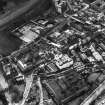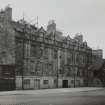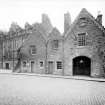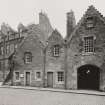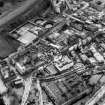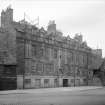Following the launch of trove.scot in February 2025 we are now planning the retiral of some of our webservices. Canmore will be switched off on 24th June 2025. Information about the closure can be found on the HES website: Retiral of HES web services | Historic Environment Scotland
Edinburgh, Abbey Strand, General
General View (Period Unassigned)
Site Name Edinburgh, Abbey Strand, General
Classification General View (Period Unassigned)
Canmore ID 124288
Site Number NT27SE 2000
NGR NT 26797 73924
Datum OSGB36 - NGR
Permalink http://canmore.org.uk/site/124288
First 100 images shown. See the Collections panel (below) for a link to all digital images.
- Council Edinburgh, City Of
- Parish Edinburgh (Edinburgh, City Of)
- Former Region Lothian
- Former District City Of Edinburgh
- Former County Midlothian
NT27SE 2000 2679 7392
NT 2678 7393 A programme of standing building recording was undertaken at Abbey Strand in May and June 2002. This involved the compilation of a photographic record and baseline architectural investigation of the buildings on the N side of Abbey Strand. Four main phases of development were identified:
Phase 1 Early 16th century.
Phase 2 Early 17th century.
Phase 3 Pre-1647.
Phase 4 Mid- to late 17th century.
These phases were sub-divided into periods of a decade each. This survey is not a complete record of the building complex, and is intended as a baseline record and as a framework for any further recording.
Archive to be deposited in the NMRS.
Sponsor: HS
G Ewart, D Gallagher and D Stewart (Kirkdale Archaeology) 2002
Depicted on the coloured 1st edition of the O.S. 1:1056 scale map (Edinburgh and its Environs, 1854, sheet 30).
REFERENCE: SCOTTISH NATIONAL PORTRAIT GALLERY
S.M.T. magazine, January 1946.
Standing Building Recording (13 May 2002 - 24 May 2002)
NT 2678 7393 A programme of standing building recording was undertaken at Abbey Strand in May and June 2002. This involved the compilation of a photographic record and baseline architectural investigation of the buildings on the N side of Abbey Strand. Four main phases of development were identified:
Phase 1 Early 16th century
Phase 2 Early 17th century
Phase 3 Pre-1647
Phase 4 Mid- to late 17th century
These phases were sub-divided into periods of a decade each.This survey is not a complete record of the building complex,and is intended as a baseline record and as a framework for any further recording.
G Ewart, D Gallagher, & D Stewart 2002
Sponsor: Historic Scotland
Kirkdale Archaeology
Standing Building Recording (10 August 2011 - 18 November 2011)
NT 2679 7393 A programme of work was carried out 10 August – 18 November 2011 on the adjoining buildings on the N side of Abbey Strand between the foot of the Canongate and the precincts of the Palace of Holyroodhouse.
Period 1 (1490–1570) Abbey Strand lies in the triangular space at the foot of the Canongate. Here the High Street led both to the palace and to the Watergate, the principal entry to the city from the E. The building lay in the precinct of Holyrood and its sanctuary but outside the main ceremonial gate of the abbey. The main block consisting of a three-storey building plus a probable attic space, 23.3m long by 7.5m wide, was built during this period. The principal N–S partition running through the building, currently denoted at ground level by the W wall of the pend, making two units, the E slightly larger than the W. Both units had a turnpike stair in their NE corner. The E one partially survives but the W one no longer exists. The surviving elaborate first floor door faces N. An arch in the room below may have supported a stair. There appears to be a blocked door on the ground floor opening from the internal E stair.
Period 2 (1570–c1630) During this period the medieval building was completely transformed for use as a high status house for courtiers. This building and the adjacent abbey gatehouse would have formed the dominant group of buildings before the entry to the palace. The entry to upper floors was from the garden to the N, which was adjacent to the royal privy garden.
Period 3 (c1630–1700) This was a period of prosperity and expansion during which the building continued to be used as a high status dwelling. The main block and the pend were extended c3.4m N. The SW–NE angle of the W wall of the extension suggests that it was constructed against an adjacent structure or boundary. The turnpike stairs continued to be used, with their N-facing doors providing access to the first floor of the N extension.
Period 4 (c1700–1916) An extra storey was added to both the main block and the N extension. The W turnpike stair was removed and the N stair built. The door from the turnpike stair was reused as the front door for the new stair. The NE jamb was added and the alteration of windows to doors at the E end of the N face of the N extension allowed access. The building was mainly used for accommodation and service activity during this period, beginning with the provision of housing for some of the respectable, though comparatively impoverished, gentry that sought refuge from imprisonment for debt in the Holyrood sanctuary. The area then declined following the construction of the New Town in the late 18th century, as the Old Town was abandoned by respectable society. The area became increasingly industrialised and Abbey Strand was subdivided to provide cheap accommodation for workers. The ground floor had a number of taverns.
Period 5 (1916–35) The building was renovated by the architect William Ross and the first clear internal plan of the building produced. The exterior was restored, the density of occupation in the tenement reduced and the ground floor public houses closed. The top floor of the main block and N extension were also removed and the size of the attic reduced. A small number of windows were altered, with those on the third floor converted to dormers.
Period 6 (1935–63) The building was declared unfit for human habitation, internal partitions were removed and the NE jamb demolished. Major renovations were also carried out on the buildings to the E of the main block, including the replacement of stonework around windows and doors, and work on the roof over the kitchen, shop and N extension. Most of the Period 3 roof beams were retained but the sarking and slates were replaced.
Archive: RCAHMS (intended)
Funder: Royal Collection Enterprises Ltd
Gordon Ewart, Kirkdale Archaeology
Dennis Gallagher,
2012


























































































































